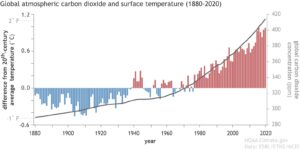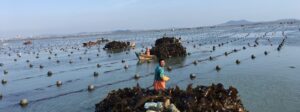Louis G. Fischer (Theme 3)
The number one problem today is as we all know the “climate crisis” and it is caused by the greenhouse effect caused by humans. The process of emitting greenhouse gases has started round about 1850 with the industrialization (Veyrassat, 2015), with the rise of the CO2 concentration and other greenhouse gases the global temperature has begun to rise as well. The concentration of the greenhouse gases and the temperature has risen equally (INFORMATION, 2008), and continue to rise. Currently the CO2 concentration in our atmosphere is at 420.49 ppm (CO2-earth, 2022) and in 1850 it were bellow 300 ppm (Peng, 2012), today we emit 40 gigatons of CO2 per year (Wurzbacher, 2021). To reach the goals from the Paris Climate Agreement we would have to cut our emissions to zero by 2050 (Wurzbacher, 2021). It is extremely difficult to reduce emitting CO2 that is why there are different approaches to take carbon out of the atmosphere, there is the natural one and the artificial one both of them have their advantages and disadvantages.

Abb. 1 Global temp. – carbondoxide (Source: ERSL/ETHZ/NCEI/climate.gov)
Natural decarbonization
Today when we think about CO2 compensation, then we most likely have in mind that a tree gets planted somewhere and that this is for sure the most famous way to take carbon out of the atmosphere, but how efficient is it to take carbon out of the atmosphere like that, is it enough and what are the advantages and the disadvantages?
Storing carbon in the soil and trees with planting trees is as already said the most known way and also the way it is already done for quite some time now. For example China has the biggest tree-planting project in the world with its “great green wall”, this project is going on since 1978, but it initial reasons where to stop the expansion of the Gobidesert and in the last decades the aspect of taking carbon out of the atmosphere came more into the focus of this project (Xiubin, 2009).
Planting trees to take carbon out of the atmosphere is so well known and widely spread because it is “so easy”, it needs relatively low resources and can be done everywhere where you have soil water and some sun. The people also have a deep connection to planting trees because they are able to do it by them self’s. Planting trees or whole forests creates and restores whole ecosystems, where for example was a desert for the last 30-40 years can now be a forest which provides habitat for animals and with that supports biodiversity. Forestation also provides socio-economic benefits, at many places where there was a forest which was deforested over the years, the social and economic situation also is not the best, reforestation can provide whole communities with jobs, food and an overall increase in quality of live (Rollan, 2017).
The critics on the other hand say, the impact of planting trees is much too small for the huge attention it gets, to take out about 10billion tons of carbon-dioxide per year it would require the area which is two to three times as big as Europe and this is just not possible (Wurzbacher, 2021). Another argument is that it has already been tried to reforest land and stop the deforestation for the last 50 years and nothing really has happened so far, the amount of forests is still decreasing (Wurzbacher, 2021).

Abb. 2 Reforestation project in the amazon (Source: Eden Reforestation Projects/edenprojects.org)
Planting trees is not the only natural way of taking carbon out of the atmosphere, one other way is the planting seaweed. The ocean stores about 38’000 gigatons of carbon and stores with that 16 times more than the terrestrial biosphere, the carbon in the ocean is stored in the ground, the water and also in the underwater vegetation (Schäfer, 2010). There is a huge potential to store carbon in seaweed, it is easy to plant and the harvested seaweed can be used very diverse. There is the danger that if the ocean stores more and more carbon, that it becomes acid and that could have a devastating impact on the marine life (Schäfer, 2010).

Abb. 3 Seaweedfarm in China (Source: Seaweed Soulutions SA/cswire.com)
There is a semi-natural way to store carbon in seaweed, a company called Brilliant Planet builds seaweed farms in the desert where the land anyway could not be used for something else. The farms are located so close to the ocean that it can use the seawater. Because they plant their seaweed not in the sea there is no threat for the ocean and they can create excellent circumstances for the seaweed to grow, currently they are able to take 30 times more carbon out of air than a forest could do on the same space (Petereit, 2022).
Artificial decarbonization
Artificial decarbonization is when the carbon is taken out or the atmosphere on an non-biological way. One way to do this is via direct air capturing, this is when you “filter” the air and take out the carbon. This technique requires three resources, water and electricity to take out the carbon out of the air (Meyer, 2020). There are several companies which research on direct air capturing, the pioneer is a Swiss company called Climeworks which has already plants in operation, their biggest plant so far is in Island, there it has access to clean energy and pumps the carbon which it has taken out of the air into the ground where it should turn into rock over the time of two years (Reykjavíkur, 2021). The problem with direct air capturing is that when you have to scale it to have an impact, to capture 1% of the emissions we produce, it would require 750’000 Climework containers and they would use 0.4%-1% of the green energy the world produces (Wurzbacher, 2021). Another way to take out the carbon of the air is the approach of the company Dimensonal Energy, they have developed an artificial photosynthesis which turns the CO2 into jet fuel, it is called carbon conversion, carbon conversion is when you turn carbon from the atmosphere in something you can use again and as we know how much consists of carbon, the possibilities are endless.
For their process, they use a sunlight refinery to produce the energy to turn carbon from the air into jet fuel. So in this case, the carbon would not be stored (Freethink, 2021), but it would be a circular process and you could turn a the jet fuel industrie CO2 neutral which is today responsible for 2.5% of all CO2 emissions (Media, 2021). The advantage with this technology is that is not only a way to take carbon out of the atmosphere, there is also a business case behind it which makes it scalable and that is the only way to make an impact. The current price of their jet fuel is still too high for the market but with further development of their technology they predict to be in the competition in not to long time from now (Freethink, 2021), but to be able to reduce their price they would also have to upscale their production plant.

Abb. 4 Founders of Climeworks in front of their plant (Source: Luca Locatelly/nytimes.com)
Conclusion
As mentioned before all of these approaches and technologies have their advantages and disadvantages. But to slow down global warming and achieve a global warming which is somewhere between 1.5°C and 2°C, we have to try everything. Some of them are currently not sustainable because they are only able to operate through the goodwill of companies and private persons, to make it count all the approaches have to step up their volume. I think the governments must devote themselves more. We often hear of those goals like the SDG’s but we rarely hear of a plan and today we have the technology, so there are no excuses. In Switzerland we have just missed a huge opportunity, with the CO2-law, towards the right direction but I am sure that the next change will come, and the people will hopefully be more educated. An optimal case would be if every product and service we consume would have to be CO2 neutral, of course we would have to change how we live because we would not be able to afford as much as we do today, but I think this is the only way to go.
References
CO2-earth. (2022, April 20). CO2.earth. Retrieved from https://www.co2.earth/daily-co2
Freethink (Director). (2021). Artificial photosynthesis turns CO2 into sustainable fuel [Motion Picture].
INFORMATION, N. N. (2008). Temperature Change and Carbon Dioxide Change. USA. Retrieved from temperaturerecord.org: https://www.temperaturerecord.org/
Media, G. C. (2021, April 12). GLOBAL CLIMATE MEDIA. Retrieved from https://www.globalclimatemedia.com/climate-change-and-flying-what-share-of-global-co2- emissions-come-from-aviation/
Meyer, J. (2020, June 26). World Economic Forum. Retrieved from https://www.weforum.org/agenda/2020/06/direct-air-capture-co2-environment-climate/
Peng, J. (2012). Effects of increased CO2 on land water balance from 1850 to 1989. Theoretical and Applied Climatology, 12.
Petereit, D. (2022, April 13). t3n. Retrieved from https://t3n.de/news/co2-algenfarm-effektiver-als- regenwald-1465142/
Reykjavíkur, O. (Director). (2021). How does Carbfix and Climeworks work? [Motion Picture]. Robin, O. R. (2003). Managing the transition from products to services. International Jurnal of Service
Industry Management, 160.
Rollan, R. L. (2017). Journal of Environmental Management. Manila Philipines.
Schäfer, D. E. (2010). Living with the oceans. Hamburg, Germany: maribus gGmbH. Retrieved from https://worldoceanreview.com/en/wor-1/ocean-chemistry/co2- reservoir/#:~:text=The%20ocean%2C%20with%20around%2038%2C000,before%20people%20bega n%20to%20drastically
Veyrassat, B. (2015, Februar 15). Industrielisierung. Retrieved from Historisches Lexikon der Schweiz: https://hls-dhs-dss.ch/de/articles/013824/2015-02-11/#:~:text=wirtschaftlicher%20Art%20waren.-
,Von%20den%20Anf%C3%A4ngen%20der%20Mechanisierung%20bis%20zum%20Eisenbahnbau%2 0(Ende%2018,Jahrhundert%20bis%201850)
Wurzbacher, J. (2021, Dezember). Climeworks eine Lösung für die Klimakrise. (F. Thelen, Interviewer) Xiubin, L. (2009). Land use Policy. United Kingdom.